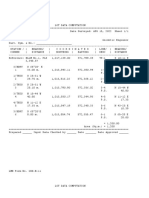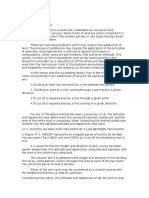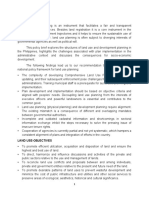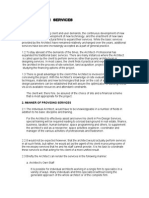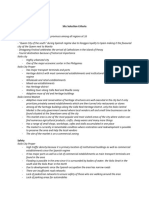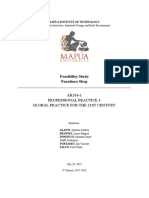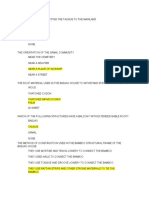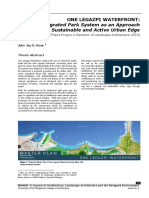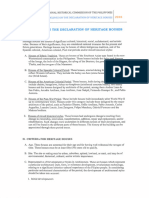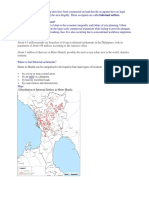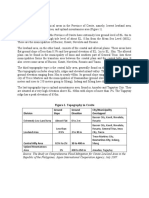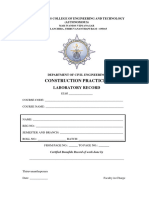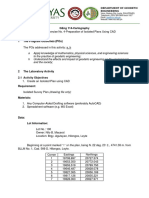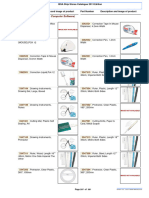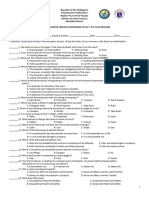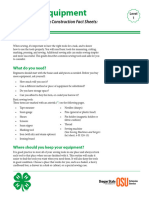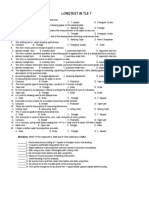Surveying (2nd Term 2020-2021)
Laboratory Exercise
Manual Plotting of a Lot Plan
OBJECTIVES:
§ To compute the Latitude and Departure of the Tie Line
§ To calculate the coordinates of the lot corners from the reference point (monument)
§ To manually plot the lot in a short bond paper (landscape format)
INSTRUMENTS AND ACCESSORIES:
§ Copy of a Land Title (individual, no duplication)
§ Latitudes and Departures of the lot lines from the previous exercise
§ Calculator
§ Ruler
§ Pencil
§ Short Bond Paper (NO OTHER PAPER)
GENERAL INSTRUCTIONS:
1. Based on the computed and summarized data from the previous exercises related to land titles,
accomplish the tables provided.
2. Make sure that all entries are correct.
3. Round-off all linear measurements with two decimal places.
4. Manually draw the lot in a clean short bond paper oriented in landscape format. No other papers
are allowed, only PLAIN SHORT BOND PAPER.
5. Do not draw border lines or any unnecessary elements.
6. You may print and fill-up the answer sheet provided or legibly write down your tabulated answers
in a sheet/s of short bond paper. You may also computerize your answers, except for the actual
plot.
7. Refer to the example for Plotting by Coordinates from Module 9 and add all the required elements
and data as stated in the procedures. Be sure to follow the steps as it will be one of the major
considerations in grading this activity.
PART I: COMPUTING FOR THE COORDINATES OF LOT CORNERS REFERRED FROM THE TIE LINE
COMPUTATION OF THE TIE LINE (REFERENCE POINT/MONUMENT TO CORNER 1):
LINE LAT DEP
BEARING DISTANCE
(RP-1) (+N -S) (+E -W)
m BLLM
S 44°35’ E 6289.93 m
No. 1 -4479.88 +4415.19
COMPUTING THE LOT CORNER COORDINATES FROM THE REFERENCE POINT:
Beginning from the reference point/monument (RP), add the computed LAT and DEP values to compute
for the coordinates (Northing and Easting) of each corner. The LAT and DEP of RP-1 is the one computed
from the table at the previous page while the other LAT and DEP values per line is from the Traverse
Computations Exercise. Make sure to correct errors from the traverse exercise if necessary.
CORNER/LINE LATITUDE DEPARTURE NORTHING EASTING
REF. PT. 20,000.00 20,000.00
RP-1 -4479.88 +4415.19
15520.12 24415.19
1
- 12.16 + 15.88
1-2
15507.96 24431.07
2
-9.53 - 7.29
2-3
15498.43 24423.78
3
+12.16 - 15.88
3-4
15510.59 24407.9
4
+ 9.53 + 7.29
4-1
15520.12 24415.19
1
Add more rows
as necessary
Add more rows
as necessary
Note: The last entry should be back to the computed coordinates of Corner 1 and not (20000,20000). The
final Corner 1 coordinates may not be exactly the same as the initial Corner 1 coordinates due to
rounding-off and/or unadjusted errors in traverse (i.e. summations of lat and dep that were not zero), but
the difference in values must not be significant (i.e. not more than 0.10 meter). If you obtained otherwise,
check your computations.
PART II:PLOTTING BY COORDINATE METHOD
MAXIMUM DIFFERENCE IN COORDINATES:
Not including the reference point, compute for the following:
Nhighest = northing of the extreme north corner
Nlowest = northing of the extreme south corner
Ehighest = easting of the extreme east corner
Elowest = easting of the extreme west corner
N’ = Nhighest – Nlowest
E’ = Ehighest – Elowest
Nhighest Nlowest Ehighest Elowest
24407.9
15520.12 15498.43 24431.07
N’ = 21.69 E’ =23.17
SOLVING FOR THE CORRESPONDING SCALE:
Maximizing the dimensions of a short bond paper (8.5 x 11 in or 21.59 x 27.94 cm) in landscape layout,
determine the map scale by doing the following steps:
1. Compute for the scale along Y-axis (N-S line):
ScaleN = Map Distance/Ground Distance = 0.2159/N’ = 1/XXXX
(Note: Get the reciprocal to get the denominator and convert to 1/XXXX format)
Solution:
2. Compute for the scale along X-axis (E-W line):
ScaleE = Map Distance/Ground Distance = 0.2794/E’ = 1/XXXX
(Note: Get the reciprocal to get the denominator and convert to 1/XXXX format)
Solution:
3. Round-UP the denominator of the two scales to intervals of 10. For example, if N’ = 25.50, the scale
is therefore 0.2159/25.50 = 1/118.1102362. The scale for N is rounded-up to 1/120 or 1:120.
4. From the two computed scales, choose the one with the larger denominator (e.g. smaller scale).
5. Add 10 to the denominator of the chosen scale. This gives enough allowance on the margins of
the paper. This becomes the computed final scale of the plan. Note that the scale is unitless (i.e.
no meters or m).
COMPUTED FINAL SCALE = 1:110
CENTERING THE LOT:
Solve for the coordinates of the center of the plot. The Ncenter and Ecenter are the coordinates of the center
of the map.
Ncenter = (Nhighest + Nlowest)/2 Ecenter = (Ehighest + Elowest)/2
Ncenter = 15509.28 Ecenter = 24419.49
SCALED DISTANCE FROM THE CENTER TO EACH LOT CORNER:
Accomplish the tables below. Use the N and E computed from Part I and the calculated Ncenter and Ecenter.
SCALED (cm) SCALED
ΔN (m) ΔE (m)
Corner SCALE ΔN’ (cm)
[N - NCENTER] [E - ECENTER]
ΔE’
10.84 -4.30 9.85 -3.91
1
-1.32 11.58 -1.20 10.53
2
-10.85 4.29 -9.86 3.90
3
1:110
1.31 -11.59 1.19 -10.54
4
Important Note: The ΔN and ΔE are the vertical and horizontal ground distances of each corner from the
center of the plot in meters, respectively. Apply the computed final scale to get the corresponding map
distances, ΔN’ and ΔE’, in centimeters.
For example, if ΔN is -12.25 meters (ground distance, GD) and the scale is 1:120 (Scale = MD/GD), the
scaled ΔN’ (map distance, MD) is -0.1021 m. Convert it to cm and the final scaled distance is ΔN’ is -10.21
cm. Since the sign is (-), plot the point 10.21 cm downwards from the center of the map (e.g. going to
South).
Use a regular ruler in measuring the scaled lengths, DO NOT USE A SCALE TEMPLATE/RULER because it will
double the scaling process and will result to unnecessarily small plots.
PART III. MANUAL PLOTTING
1. Get a clean sheet of short bond paper (8.5 x 11 in). Do not put border on the paper.
2. Using a regular (not scale) ruler and pencil, lightly draw a horizontal and a vertical line to mark the
exact center of the paper.
3. From the center and using a regular ruler, plot Corner 1 using the scaled ΔN’ (cm) and ΔE’ (cm)
previously computed and tabulated. Always note that ΔN’ is the vertical distance and ΔE’ is the
horizontal distance from the center of the paper. Be careful in plotting: (Y, X) instead of (X, Y).
4. If the scaled ΔN’ is positive, plot the length upwards (to North) from the center; if ΔN’ is negative, plot
the length downwards (to South) from the center. Likewise, if the scaled ΔE’ is positive, plot the length
towards the right side (to East) from the center; if ΔE’ is negative, plot the length towards the left side
(to West) from the center.
+ scaled ΔN’ + scaled ΔN’
- scaled ΔE’ + scaled ΔE’
- scaled ΔN’ - scaled ΔN’
- scaled ΔE’ + scaled ΔE’
5. Repeat steps 3 and 4 for all the remaining corners.
6. Mark the corners using a 2-mm (diameter) circular template. Label the corner numbers accurately
beside each circle, preferably outside the plot.
7. Connect the corners to form the boundary lines. Make sure that the lines do not intersect the circle.
8. On any vacant portion of the paper (but preferably at the upper left corner), write a tabulated
technical description and tie line similar to the table in the Extracting the Lot Information and Technical
Description from a Land Title exercise. If there is not enough space for the whole table, just label the
sides of the lines with its correct bearing and distance and then just add a table for the tie line. Refer
to the sample below. Redundant tabulated technical description and labelled boundary lines is
unnecessary.
9. Check if the lines drawn correspond to their actual bearing and distance from the technical
description table.
10. Plot the adjacent lots/properties. Indicate the Lot, Blk, and Survey Number inside the plot, as well as
the Lot Area. Refer to the sample below.
11. Finally, indicate the Name of Claimant, Location of the Lot (Brgy, Mun/City, Province, Island), Numeric
Scale (1:XXXX) and place a North Arrow anywhere appropriate on the map, considering aesthetics
and legibility.
12. You may ink your work or just use a sharp, dark pencil. Make sure that your submission will be clear
and readable.
13. Submit the calculation tables and the scanned or properly photographed manual lot plan in
Blackboard. If you will not be scanning the plot, please photograph the lot plan in TOP VIEW as much
as possible to avoid improper checking/grading due image distortions.

